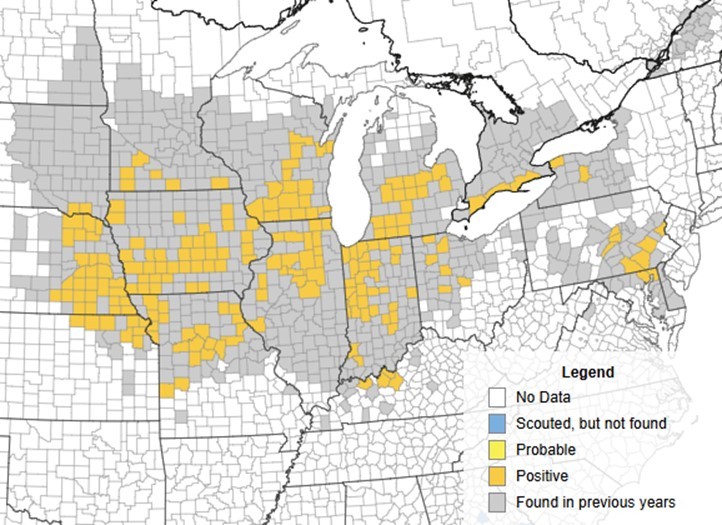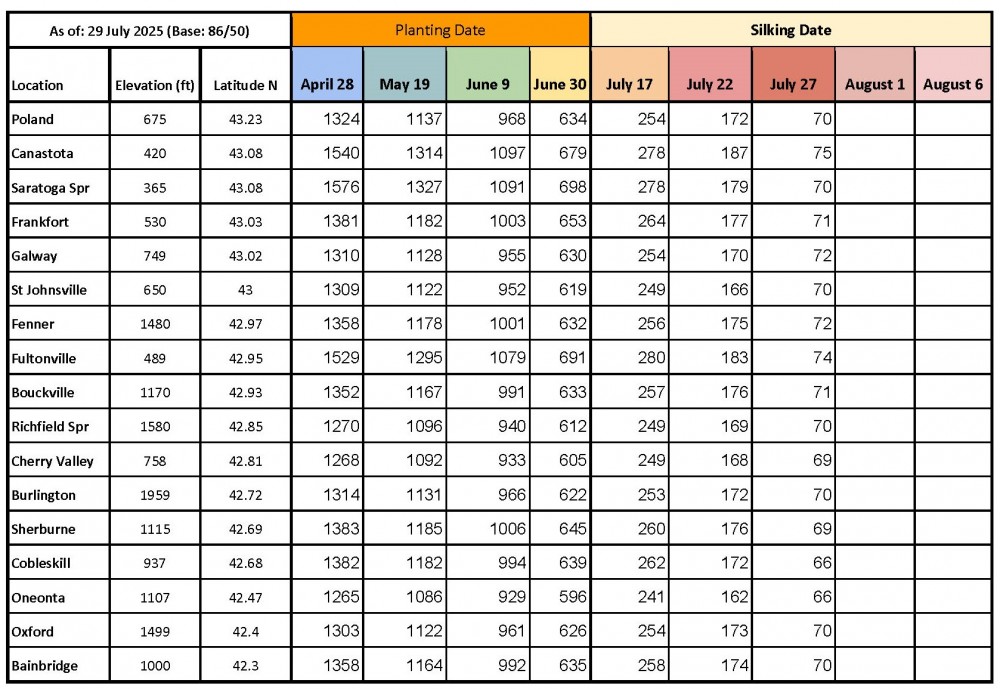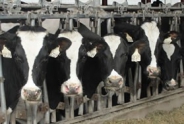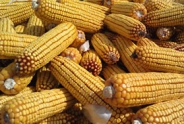Field Crop Update, July 31, 2025
Erik Smith, Area Field Crop Specialist/Team Leader
Central New York Dairy and Field Crops
1. Field Observations
The biggest thing I've noticed the past few weeks has been the lack of rain. Thankfully we're all receiving some much-needed rain today. Corn crops are tasseling and soybeans are flowering and truly filling out. Crops planted later in the spring have been the hardest-hit by the dry conditions, so this rain is very timely for both those later crops and for the flowering corn and soybeans.
2. Pests and Disease
The past week of hot, dry weather allowed potato leafhopper to proliferate and cause damage to alfalfa across the state. Steady rains can help alleviate PLH outbreaks by washing them off their host plants, so hopefully today's rain does the trick.
Have you had any grain disease problems or rejections due to vomitoxin/DON? Let me know, as we'd like to learn more about where and how these problems arise.
And I know it's not a field crop issue, but late blight has been detected on potatoes and tomatoes in western NY (strain US-23, susceptible to mefanoxam (Ridomil)), so if you're growing these crops, do what's necessary to protect them before the disease makes its way to CNY in the coming week(s). And get in touch with your local veg extension staff if you suspect an outbreak in your crops.
This year we're also monitoring fields around the state for corn leafhopper, which is a vector for corn stunt disease. So far, it's only been detected as far north and east as Missouri, but any one of these weather systems could bring them into our area, so I'll keep you all in the loop as we receive updates.
Tar spot of corn has been spotted in NY for the first time this year in Livingston and Niagara counties (see map below), so please be on the lookout - and get in touch with me if you suspect it in your fields.

3. Growing Degree Days (GDD) (See: Climate Smart Farming Growing Degree Day Calculator)
Growing degree days (GDD) are calculated by taking the average daily temperature and subtracting the base temperature for development of a given organism ((High + Low)/2 - base temp = GDD). For corn silage, we are using base 50/86, as corn development starts at 50 degrees F and ceases above 86. Check your location and planting date.
The silking dates in section 2 begin July 17th, when I first saw tasseling in the region - so this does not mean that every crop in your particular area tasseled on that earliest date. Your crop may have tasseled on or more closely to one of the later dates. So While our GDD tables in section 2 can get you in the ballpark, check your own whole-plant DM to make sure you're ready, and not ahead/behind schedule!
Remember: Silage corn needs 750-800 GDD (depending on hybrid maturity) after silking to reach a whole plant DM of 32%. Under typical late season dry down conditions we can expect the crop to reach 35% DM four to seven days later. We can expect to accumulate 15-25 GDD per day, or even up to 30, so peak maturity can creep up on us quickly. But no matter what the numbers say, always check your crop to see how close you may be to harvest. For more details, see this article.


Upcoming Events
Labor Roadshow IX
December 1, 2025
December 9 - December 10, 2025December 17 - December 18, 2025December 22, 2025
In-person and online events to keep NY's agricultural employers informed and prepared for today's labor challenges.
Inspired by Annie's: How to Be a Strong Woman Farm Manager
January 10, 2026
January 17, 2026
Free webinars geared towards women who own or operate a farm in NYS.
2026 Dairy Day
January 13, 2026 : Dairy Day - Hamilton
Hamilton, NY
Lunch included
January 14, 2026 : Dairy Day - Ballston Spa
Ballston Spa, NY
Lunch included
Announcements
Statewide Field Crop Pathology Needs Assessment Survey
Your input is wanted for identifying priorities!Sign Up for Our Weekly E-Newsletter
We send out a bi-weekly e-newsletter that has announcements, upcoming programs, and opportunities for you! Registration is quick, easy, and free. Click here to sign up today!Farmers Can Join MeatSuite For Free!
MeatSuite.com is a free resource provided by Cornell University where NY meat farmers can create a farm profile and list their bulk (wholes, halves, quarters) and bundled (i.e. Grilling Bundle) meat products.Why should farmers join?
1. It's free and easy!
2. Connect with more local customers. In the past year the MeatSuite.com farm directory had 8,300 visits from New York consumers. Farm profiles get as many as 25 views per month from potential local customers. We also spotlight MeatSuite farms on social media and bring attention and purchases to farms through highlights and giveaways.
How do I join?
Farmers can visit https://www.meatsuite.com/farmers/ to create a free farm profile. You must list at least one product for your farm's profile to go live. You'll also have access to Cornell's free Meat Price Calculator, a helpful tool for pricing your meat to make a profit.
While you're on MeatSuite, check out the "Creating Consumer-Friendly Bulk Meats" publication on the log-in page. It has tips on how to create bulk meat products that are easier for first-time buyers to say "yes" to.
If you have any questions as you create your farm profile or products, we're here to help! Please email Matt LeRoux at mnl28@cornell.edu.




